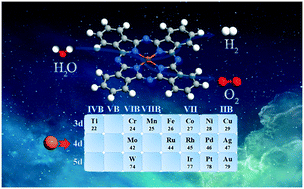Enhanced electrochemical oxygen evolution reaction activity on natural single-atom catalysts transition metal phthalocyanines: the substrate effect†
Abstract
The oxygen evolution reaction (OER) plays a crucial role in the field of renewable and clean energy such as electric vehicles and fuel cells. Research towards non-noble metals and highly efficient catalysts for the OER has garnered wide attention. Here, we report a series of macrocyclic transition metal phthalocyanines (TMPc) and transition metal phthalocyanine absorbed oxygen or sulfur atoms (TMOPc and TMSPc), natural photocatalytic and electrocatalytic OER single-atom catalysts (SACs). The results demonstrate that they are all semiconductors and extremely stable. Several Pc SACs such as FeOPc and PtPc show excellent high catalytic activity compared with traditional noble metal catalysts and an OER descriptor of the Pc SACs is developed to establish a volcano plot. In particular, FeOPc features a low overpotential of only 0.48 V. Moreover, single-walled nanotubes (SWNTs) are employed as the substrate of TMPc to improve the stability of active sites and prevent aggregation. The result indicates that the TMPc single-atom catalysts deposited on SWNTs feature far superior OER catalytic performance. Further studies suggest that the enhancement originates from the change of interaction between the central TM atom and OER intermediates and the variation of charge transfer caused by the SWNT substrates. Our work opens a new avenue for finding OER catalysts with higher activity and lower cost.



 Please wait while we load your content...
Please wait while we load your content...